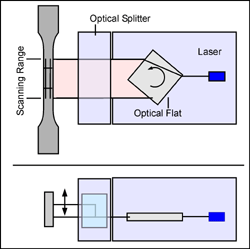
The laser extensometer P-50D is used for non-contact measurement of strain, compression, or motion of specimen along two scanning lines. A laser beam is directed onto a rotating optical flat. During entering and leaving the laser beam is refracted at two opposite planes of the optical flat which results in an identical refractive angle. By the rotation of the optical flat, the laser beam is deflected in parallel to itself and scans along the specimen. The P-50D includes an optical beam splitter which generates two scan lines. One scan line is fixed, the other is adjustable in horizontal position. The distance between the scan lines can be adjusted by the user between 0 and 20 mm - other ranges are available on request. The extensometer is optimized for experiments like shear strain, crack opening and bending tests. 3 Point Bending Test
Shear Tensile Test
|